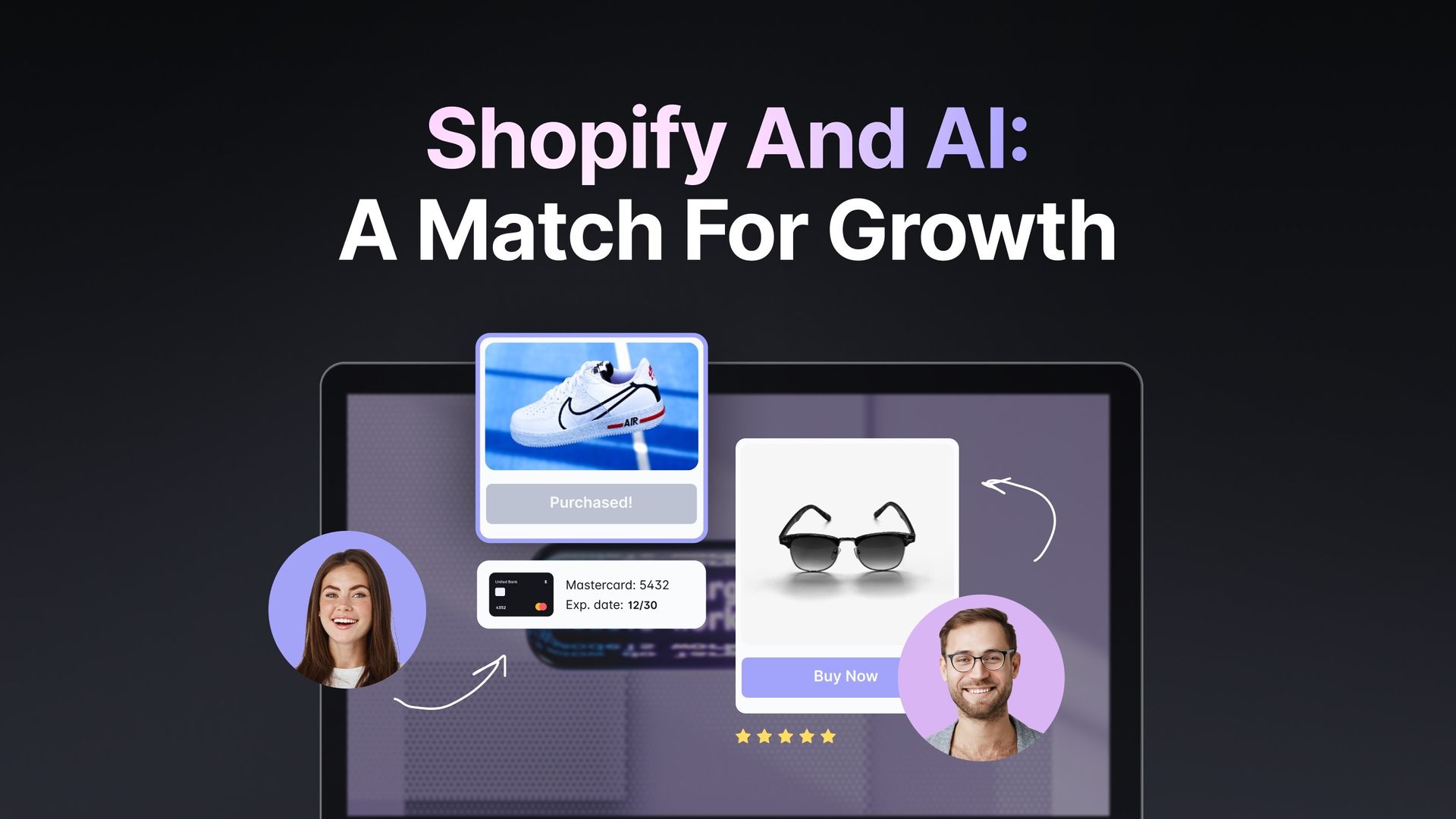Tech
A Practical Guide to Integrating AI into Your Shopify Store

As a Shopify merchant, you can now access a vast array of AI capabilities that can help optimize major aspects of your eCommerce operations for greater growth and success.
In this guide, we’ll explore how Shopify sellers can effectively incorporate AI into their business across different functions.
Takeaways
- Start with focused use cases - identify pain points like improving images or recommendations.
- Invest in top AI software tailored for eCommerce, such as Claid.
- Curate AI outputs - refine tool results to fit your brand.
- Track metrics - monitor key indicators of success per initiative.
- Expand usage - once integrated, widen AI applications for greater impact.
How you can use AI as a Shopify store owner
Shopify store owners can leverage AI to enhance various aspects of their business. Automation comes into play by streamlining repetitive tasks and optimizing inventory forecasting, paving the way for efficiency.
In the realm of visuals, AI enables the generation of high-quality product photography and image editing, adding a professional touch to product presentations. This technology also extends to crafting personalized experiences through tailored recommendations and personalized search, fostering customer engagement.
The growth potential is further amplified with AI-driven strategies like cart abandonment reduction. Together, these applications—spanning product photography, search personalization, inventory management, content generation, and customer service chatbots—form a cohesive strategy to enhance eCommerce competitiveness.
Producing High-Quality Product Images with AI
High-quality product photography is essential for eCommerce success. Gen AI tools can automatically create unique, photorealistic product images to boost your catalog.
Use Cases
- Populate product categories that lack quality reference images.
- Continuously experiment with new product visuals and identify top performers.
- Personalize images for local markets and languages.
- Create immersive 3D interactive previews.
- Render lifestyle context images with products in use.

Key Tools
- Claid: Claid’s AI Photoshoot uses AI to generate countless engaging product images tailored to your needs. This helps rapidly expand your catalog without expensive photoshoots.
- LetsEnhance.io: Generates images from text and comes with built-in enhancement capabilities.
- Nvidia GET3D: Creates photorealistic 3D model renders of your products from 2D image.
- Zmo.ai: Generates new clothing images on models with your chosen patterns, textures, and styles. Helps create comprehensive fashion catalogs.
Implementation Tips
- Use clear, consistent prompts for best AI results. Check out Claid’s guide.
- Curate generated images to identify and reuse top performers.
- Enhance AI images further with intelligent editing features.
- Combine AI generation with some high-quality human photography for ideal catalog.
Enhancing and Editing Product Photos with AI
While AI generation can create new images, it’s also crucial to polish and perfect the photos you already have. AI makes this fast and easy.
Use Cases
- Remove backgrounds consistently across catalog images.
- Adjust colors and lighting for on-brand consistency.
- Sharpen image resolution for high-quality views.
- Intelligently crop and resize batches of images.
- Identify and fix subtle image flaws.

Top Tools
- Claid: Offers specialized eCommerce editing tools like background removal, color correction, upscaling, and more.
- Adobe Photoshop: Has AI-powered features like object selection, skin smoothing, noise reduction, and intelligent filters.
- LetsEnhance.io: Uses AI to upscale product images up to 16X, enhancing resolution and details.
Implementation Tips
- Use automation to edit images at scale vs. manually.
- Leverage smart cropping to highlight products.
- Focus AI on improving image quality not altering product.
- Fine-tune AI adjustments to maintain brand style.
- Re-edit old images to improve catalog consistency.
Personalizing the Customer Experience with AI
Recommendation engines use data to provide tailored suggestions, offers, and content for each customer. This personalization drives engagement, satisfaction, and sales.
Main Use Cases
- Provide personalized product suggestions throughout customer journey.
- Tailor content and promotions based on purchase history data.
- Offer abandoned cart recovery discounts through retargeting.
- Craft customized email sequences per user segment.
Personalization Tools
- glood.ai: Suggests complementary products based on data like frequently purchased together items.
- AI-Search: Personalizes on-site search results and product recommendations for each user.
- Ada: AI-powered conversational chatbot that provides customized support and product suggestions.

Tips for Implementation
- Offer suggestions across all touchpoints e.g. product page, cart, email.
- Balance personalized recommendations with inventory needs.
- Ensure chatbot conversational flow aligns with customer needs.
- Follow up on any purchases with relevant recommendations.
Optimizing Inventory Planning and Supply Chain with AI
AI analytics can help forecast demand more accurately so you have optimal inventory levels and avoid stalled or excess stock.
Use Cases
- More accurately plan inventory volumes, reduces waste.
- Identify trends and seasonal demand shifts.
- Predict future bestsellers using external data.
- Optimize delivery routes for reduced logistics costs.
Key AI Tools
- Smart Purchase Orders: Uses ML algorithms on historical and external data to create demand forecast models and inventory optimization recommendations.
- Trendsi: Sources quality brands & products, packing & shipping with your invoice, handling returns, and customizing packaging - no inventory needed.

Tips for Implementation
- Clean up historical sales data for quality model inputs.
- Regularly update models to account for new patterns.
- Use simulations to stress-test inventory plans.
- Connect predictive outputs to ordering workflows.
- Monitor KPIs like waste reduction and supply chain costs.
Generating Engaging Product Page Content with AI
AI copywriting assistants like Jasper, Copy.ai, and ChatGPT can generate product descriptions, titles, and other content to enhance product pages.
Use Cases
- Auto-generate unique SEO meta titles and descriptions at scale.
- Produce consistent, on-brand descriptions across catalog.
- Refresh outdated legacy product content.
- Create localized page content for various languages.
Key AI Content Tools
- Jasper: Creates SEO-optimized, on-brand product page content with aspects you customize like tone, length, keywords, etc.
- Product Description Generator by Ahrefs: Specifically designed for eCommerce, can produce product descriptions in different styles.
- ChatGPT: OpenAI's AI copywriter trained to generate various forms of textual content including eCommerce copy.
Tips for Best Results
- Ensure sufficient training data reflecting brand voice.
- Curate and edit highest quality AI outputs.
- Balance SEO goals with enticing sales copy.
- Specify content structure, length and other parameters.
- Regenerate periodically to keep content fresh.
Use Conversational AI for Customer Service and Beyond
Intelligent chatbots can provide 24/7 automated customer support, freeing staff for complex issues.
Major Use Cases
- Provide instant answers for common pre-sales questions.
- Simplify order tracking, returns, and other support workflows.
- Assist with cart abandonment through personalized reminders.
- Route complex technical/order issues to human agents.
AI Chatbot Tools
- Ada: Supports various messaging channels with intelligent conversational flow. Can also collect customer feedback.
- Shopify Sidekick: New Shopify-native AI Sidekick isn't a typical support bot. By accessing your website's data, it offers specific support tailored to each entrepreneur and business, including explaining sales trends, answering FAQs, and editing website themes..
- Tidio: Specifically designed for Shopify, Tidio is a customer experience platform for online stores, offering live chat and email marketing to enhance service.

Tips for Implementation
- Align chatbot capabilities to top customer service needs.
- Continuously expand the knowledge base and improve conversation flow.
- Set up intelligent hand-off to agents for complex issues.
- Monitor chatbot NPS, CSAT, and containment rate.
Supercharge Your Shopify Store with AI
AI offers a transformative way to enhance sales, efficiency, and customer satisfaction in your Shopify operations. To experience these benefits first-hand, try Claid, a solution tailored for eCommerce. Get 20 free credits upon creating an account, and take the next step in unlocking your store's potential.

Claid.ai
August 28, 2023